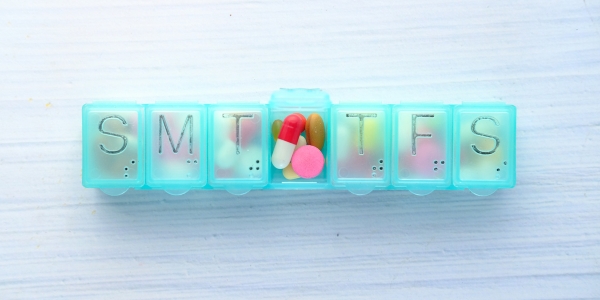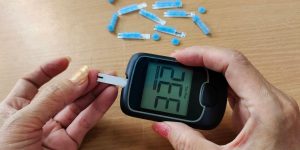The first time I was diagnosed, I swear the doctor handed me a pamphlet that was longer than War and Peace. Seriously. It was overwhelming. And, full disclosure? I’ve made pretty much every mistake in the book (and probably invented a few new ones). So, let’s learn from my blunders, shall we? This isn’t your grandma’s diabetes advice (unless your grandma is super cool and slightly snarky, like mine).
Mistake #1: The “Blood Sugar Ghosting” Game

We all know we should be checking our blood sugar regularly. It’s, like, Diabetes 101. But let’s get real: life happens. Work gets crazy, the kids are screaming, you’re binge-watching that new show on Netflix… and suddenly it’s been, uh, a while since you last pricked your finger.
I used to think I could “feel” my blood sugar. High? I’d get a little jittery. Low? Maybe a bit shaky. Turns out, my internal blood sugar sensor is about as accurate as a weather forecast in April. (Which is to say, not at all).
The truth is, regular monitoring is the only way to truly know what’s going on. It’s like having a GPS for your body. Without it, you’re driving blind. And, friend, that’s a recipe for a crash (pun absolutely intended).
The Fix:
- Make it a Ritual: Pair testing with something you already do. Before your morning coffee? Boom. Before brushing your teeth at night? Done. I even set a recurring alarm on my phone. (It plays a ridiculously upbeat song – gotta counteract the finger-pricking somehow!).
- Embrace Technology: Consider a continuous glucose monitor (CGM). Seriously, these things are game-changers. No more finger sticks! It’s like having a tiny, tireless robot constantly checking your levels. (Okay, maybe not a robot, but you get the idea).
- Hand-Washing is Non-Negotiable: Before every test, wash your hands thoroughly with soap and water. Residues on your fingers (from food, lotion, etc.) can seriously skew the results. We’re aiming for accuracy, people!
- Keep a Log (Digital or Paper): Write it all down! Include your blood sugar readings, notes about food intake, exercise, and any medications you took. This helps you and your doctor identify patterns and make adjustments.
- Know Your Targets: Work with your doctor to figure out your ideal range. What’s good for one person might not be good for another. We’re all unique snowflakes, even our pancreases.
Mistake #2: Becoming One with the Couch

Okay, I’m going to be brutally honest here. My idea of a “workout” used to be lifting the remote control. I knew exercise was important, but… ugh, effort. Plus, the gym felt like a torture chamber filled with suspiciously fit people.
But here’s the thing: exercise isn’t just about looking good in skinny jeans (though that’s a nice bonus). It’s crucial for managing blood sugar. Think of your muscles as little sugar-hungry monsters. The more you move, the more they gobble up that glucose.
The Fix:
- Find Something You Actually Enjoy: Hate running? Don’t run! Love dancing? Crank up the music and shake it! Walking the dog? Gardening? Even chasing your kids around the house counts.
- Start Small: Don’t try to become a marathon runner overnight. Even 10-15 minutes of activity a day is better than nothing. I started by walking around the block. Now I can almost keep up with my hyperactive Labrador. (Almost.)
- Break It Up: Three 10-minute bursts of activity are just as good as one 30-minute session. Perfect for those of us with the attention span of a goldfish (guilty!). I would recommend 150 minutes spread throughout the week.
- Strength Training Matters: Don’t just focus on cardio. Building muscle helps your body use insulin more effectively. You don’t need fancy equipment – bodyweight exercises (like squats and push-ups) work great.
- Carry Carbs: Always have a fast-acting source of carbohydrates with you (like glucose tablets, juice, or regular soda) in case of hypoglycemia (low blood sugar). This is especially important when exercising.
Mistake #3: The “Carb Confusion” Diet

I used to think “low-carb” meant “no fun.” I envisioned a life of sad salads and flavorless chicken breasts. Turns out, I was doing it all wrong.
It’s not about eliminating carbs completely (your brain needs them to function!). It’s about choosing the right carbs. Think of it like this: some carbs are like sprinters – they give you a quick burst of energy (and a sugar spike). Others are like marathon runners – they provide sustained energy without the crash.
The Fix:
- Embrace the Rainbow: Load up on colorful veggies. They’re packed with nutrients and fiber, which helps slow down sugar absorption. Think of your plate like a canvas; it should look vibrant and nutritious.
- Choose Whole Grains: Swap white bread, pasta, and rice for their whole-grain counterparts. They’re higher in fiber and take longer to digest. Aim for a fist-sized portion of whole grains per meal.
- Don’t Fear Fruit (in Moderation): Fruit does contain sugar, but it also has vitamins and fiber. Just don’t go overboard.
- Portion Control is Key: Even healthy foods can spike your blood sugar if you eat too much. Use smaller plates and measuring cups to keep portions in check.
- Get the Good Fats: Incorporate healthy fats like those found in avocados, nuts, seeds, and olive oil. These fats are beneficial for heart health and can help you feel full and satisfied.
- Talk to a Dietitian: Seriously, these people are food wizards. They can help you create a meal plan that’s both healthy and delicious.
Mistake #4: The Medication Muddle

This one’s a biggie. I used to be terrible at taking my meds on time. I’d forget, I’d get distracted, I’d convince myself I didn’t need them… (Sound familiar?).
But skipping doses or messing with your medication schedule is like playing Russian roulette with your blood sugar. It’s dangerous, and it can lead to serious complications.
The Fix:
- Pill Organizers are Your Friend: Those little plastic boxes with the days of the week? Life-savers.
- Set Reminders: Use your phone, your watch, a smart speaker – whatever works for you.
- Understand Your Meds: Know why you’re taking each medication and how it works. Ask your doctor or pharmacist if you’re unsure.
- Don’t Be Afraid to Ask for Help: If you’re struggling to afford your meds, talk to your doctor. There may be programs or resources available to assist you.
- Simplify When Possible (With Doctor Approval): If your doctor agrees, explore options for simplifying your medication regimen. This might include once-daily dosing or combination medications. Never make changes without consulting your physician.
- Don’t adjust without talking to a doctor!: Never change a medication without talking to a pro.
Mistake #5: Stress City and Sleep Deprivation (My Personal Demons)

Stress and lack of sleep? They’re like the evil twins of diabetes management. They can wreak havoc on your blood sugar, even if you’re doing everything else “right.”
I used to think stress was just a part of life. And sleep? Who has time for that? (Famous last words, right?)
But chronic stress and sleep deprivation are like pouring gasoline on a fire. They make your body release hormones that raise your blood sugar and make it harder for insulin to do its job.
The Fix:
- Find Your Zen: Yoga, meditation, deep breathing exercises – whatever helps you chill out. I even tried adult coloring books. (Turns out, I’m terrible at staying in the lines, but it’s surprisingly relaxing!).
- Prioritize Sleep: Aim for 7-9 hours of quality sleep each night. Create a relaxing bedtime routine. Make your bedroom a sleep sanctuary (dark, quiet, and cool).
- Say “No” More Often: You don’t have to do everything. Learn to set boundaries and protect your time.
- Seek Support and Professional Help: Talk to a therapist, counselor, or trusted friend if you’re struggling with stress, anxiety, or feeling overwhelmed. There’s no shame in asking for help, and it can make a huge difference in your overall well-being.
The Takeaway
Diabetes management is a marathon, not a sprint. There will be good days and bad days. You’ll stumble, you’ll fall, you’ll probably eat that entire box of cookies at some point (we’ve all been there).
The key is to keep learning, keep trying, and keep showing up for yourself. And if all else fails? Well, remember you are not alone and keep your medical team close. You’ve got this! (And so do I… hopefully!).
References
- Effectiveness of Continuous Glucose Monitoring in Improving Glycemic Control and Reducing Hypoglycemia: A Systematic Review and Meta-analysis
- The Use of a Real-Time Continuous Glucose Monitoring System to Improve Glycemic Control in Patients With Type 1 Diabetes: A Randomized Controlled Trial
- Accuracy of newer generations of long-term continuous glucose monitoring systems
- Impact of Self-Monitoring of Blood Glucose in the Management of Patients with Non-Insulin Treated Diabetes: A Meta-analysis of Randomized Controlled Trials
- Exercise Improves Glycemic Control and Cardiovascular Risk Factors in Individuals with Type 2 Diabetes: A Systematic Review and Meta-analysis
- Effect of Aerobic and Resistance Exercise on Glycemic Control, Insulin Sensitivity, and Cardiovascular Risk Factors in Type 2 Diabetes: A Randomized Controlled Trial
- Association of Daily Step Count With Glycemic Control in Adults With Type 1 or Type 2 Diabetes
- Exercise for type 1 diabetes
- Dietary Approaches to Prevent and Manage Type 2 Diabetes: A Systematic Review and Meta-analysis of Randomized Controlled Trials
- Effect of a Low-Carbohydrate Diet on Glycemic Control in Individuals with Type 2 Diabetes: A Meta-analysis of Randomized Controlled Trials
- The Effect of Dietary Fiber Intake on Glycemic Control, Cardiovascular Risk Factors, and Weight Loss in Individuals with Type 2 Diabetes: A Systematic Review
- Healthy Dietary Approaches for Prevention and Management of Type 2 Diabetes: Consensus Statement from the American Association of Clinical Endocrinologists and American College of Endocrinology
- Interventions to Improve Medication Adherence in Patients with Type 2 Diabetes: A Systematic Review and Meta-analysis
- The Impact of Medication Non-Adherence on Glycemic Control and Health Outcomes in Adults with Type 2 Diabetes
- Factors Associated with Medication Non-Adherence in Patients with Type 2 Diabetes
- The Association Between Stress and Glycemic Control in Individuals with Type 2 Diabetes: A Systematic Review and Meta-analysis
- Sleep Duration and Quality in Relation to Glycemic Control in Individuals with Type 2 Diabetes
- Stress Management Interventions for Improving Glycemic Control in Adults with Type 2 Diabetes: A Systematic Review
- The association between sleep duration, insulin sensitivity, and β-cell function: the EGIR-RISC study




